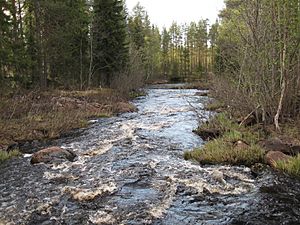Rapids facts for kids

Rapids are exciting parts of a river where the water flows very fast over and around rocks. Imagine a river that suddenly gets bumpy and splashy – that's a rapid! They are often found in mountain areas, especially closer to where a river begins, also known as its "headwaters." The word "rapids" is always used in a plural way, like "scissors" or "trousers," even when talking about just one section of fast water. The word "rapid" itself means "very fast."
Because the water crashes and splashes over the rocks, creating lots of white foam and bubbles, rapids are also known as "whitewater." Many people enjoy sports like whitewater canoeing or whitewater rafting, which involve navigating these thrilling sections of a river.
Contents
How Do Rapids Form?
Rapids are created by a mix of geology and the power of flowing water. They usually form in places where the riverbed, which is the bottom of the river, is made of hard, resistant rock. As the river flows, it slowly wears away softer rocks and soil. However, when it hits a patch of harder rock, the water struggles to erode it as quickly. This causes the riverbed to become steeper or to have large rocks sticking up.
Over time, these hard rock sections create obstacles that force the water to speed up and become turbulent. The river might also flow over a sudden drop in elevation, like a small waterfall, which then leads into a rapid. This constant movement of water also carries sediment and smaller rocks, which act like sandpaper, slowly shaping the riverbed and making the rapids more pronounced.
Where Can You Find Rapids?
Rapids are common in many parts of the world, especially in areas with mountains or hilly landscapes. Rivers flowing down from high elevations often have rapids because the land is steeper, and the water gains speed. You can find them in places like the Rocky Mountains in North America, the Alps in Europe, or the Himalayas in Asia.
They are also found in areas where the land has been shaped by glaciers, which can leave behind rocky terrain. Even in flatter regions, if a river flows over a geological fault line or a hard rock formation, rapids can form. They are a natural part of a river's journey from its source to the sea.
Whitewater Sports and Safety
Whitewater sports are popular activities that let people experience the thrill of rapids up close. Whitewater rafting involves a group of people paddling a large inflatable raft down a river, guided by an experienced leader. Whitewater canoeing or kayaking uses smaller, more agile boats for one or two people.
These sports can be very exciting, but safety is always the most important thing. People participating in whitewater activities always wear life jackets and helmets. They also learn how to paddle, how to stay safe if they fall out of the boat, and how to work together as a team. Rivers are often classified by how difficult their rapids are, from easy "Class I" rapids to very challenging "Class VI" rapids, which are considered too dangerous to run.
Rapids and Nature
Rapids are not just fun for sports; they are also important for the environment. The fast-moving, oxygen-rich water in rapids creates unique habitats for certain types of fish and insects. Some fish, like salmon, need to swim up rapids to reach their spawning grounds where they lay their eggs.
Rapids can also be a source of clean energy. Sometimes, hydroelectric power plants are built near rapids or waterfalls to use the force of the flowing water to generate electricity. This is a way to produce power without burning fossil fuels, which helps protect our planet.
Images for kids
-
Rapids featuring whitewater, close to the Rhine Falls
-
Violent water below Niagara Falls
-
Rapids on the Mississippi River (Ontario) in Pakenham, Ontario, Canada.
-
Historical image of the river rapids on the Maumee River in Ohio
See also
 In Spanish: Rápido para niños
In Spanish: Rápido para niños





